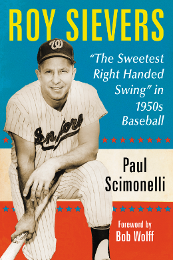Could the Washington Senators win a third consecutive American League pennant? Most believed the answer was no. Then again, nobody expected the Nats to win the 1924 pennant and World Series and the 1925 pennant. Now in 1926, were those so-called experts, once again, underestimating the Senators?
Back in 1924, shortly before the start of spring training, Washington team owner Clark Griffith surprised the sports world by naming youthful second baseman Bucky Harris as the Senators new manager. With just a little over four years of major league playing experience since arriving in Washington in 1919, Harris seemed like an unlikely candidate. The sportswriters had a field day with his hiring, tabbing it as “Griffith’s folly.” A Chicago sportswriter, blinking his eyes in disbelief as he sat before his typewriter, believed the inexperienced new manager was setup to fail. “Our sympathy goes out to Bucky Harris,” he told his readers. But it was Griffith who would have the last laugh.
The rookie manager believed in his heart that his team would contend in 1924 and he wasn’t shy about letting the sportswriters know. “Most Washington teams I know are playing out their schedule by the end of July,” a writer replied to Harris with a smile. But when the end of July arrived, Washington was locked in a tight pennant race with the Yankees and Tigers. Then reality set in that the Senators could do it when they held a slim first place lead over the Yankees and Tigers as they hit the road to finish out the season. At Boston, on the second to last day of the 1924 campaign, the seemingly impossible came true when Bucky Harris fielded a ground ball, stepped on second, and then threw to first base in time to complete a game-ending double play for a 4-2 win to officially clinch the first pennant in team history.
Winning the American League championship meant the great Walter Johnson’s loyalty of pitching for the usually second division Senators throughout his eighteen-year career was finally rewarded. The greatest pitcher of all-times, known for his kind heart and his blazing fastball, was on his way to his first World Series, which warmed the hearts of admiring baseball fans from coast-to-coast. Throughout the season the fans had voiced their approval in favor of the underdog Senators, and Walter Johnson, who would finally have the opportunity to fulfill a career-long dream of hurling a World Series victory.
The Senators entered the World Series as the underdog to the experienced New York Giants. Very few gave Washington a chance, but the consolation was the belief of Walter Johnson hurling a World Series win.
Surprisingly, the Senators put forth a fight that resulted in a split of the first six games to force a game seven, which would be played in Washington. It was thrilling for most fans to see Washington with a good chance to upset the Giants and become World Champions, but the heartbreak would be for poor Walter Johnson’s dream going unfulfilled. The great pitcher had been defeated in his two starting assignments in games 1 and 5. With little time to rest his arm, it appeared most unlikely for Johnson to appear in game 7.
Washington rallied with two runs in the bottom of the eighth to tie the deciding game, 3-3. And then in the top of the ninth, much to the delight of the Griffith Stadium crowd and fans everywhere, Walter Johnson entered the game in relief. As fate would have it, the Senators scored one in the bottom of the twelfth to win the World Series, and finally give Johnson his first World Series victory.
Before the 1925 season, the writers ruled out Washington for a repeat, claiming it was almost impossible for the Senators to “luck” their way to another championship. The Yankees, three-time league champs before Washington broke their string, were the overwhelmingly favorite. So confident were the New York players, they announced they had “already won the pennant” before the season even began. “So I heard,” said Bucky Harris when asked about New York’s preseason prognostication. “You tell them that it they win the pennant, which they won’t, that they would beat out a better team Washington team in 1925 then the one they failed to beat in 1924.”
The Yankees 1925 season turned from overconfident to desperation when Babe Ruth was sidelined with his famous bellyache before the season began. When he returned to action, he had no chance of helping the slumping Yankees who fell out of contention early in the season. Babe Ruth’s illness and his poor season that followed, an unsettled infield, and a disappointing season from the pitching staff, resulted in a seventh place finish for New York.
With the Yankees out of the way, the up-and-coming Philadelphia Athletics filled the role of contending with the Senators. The two teams ran neck-and-neck throughout the summer until the youthful A’s went into a tailspin to knock them out of contention. Washington won the pennant by finishing 8 1/2 games ahead of the A’s, and entered the World Series with confidence of winning a second in a row.
Leading the way to Washington’s drive to their second straight league title was Walter Johnson. A twenty-three game winner in his 1924 American League MVP season, Baseball’s Big Train won twenty in 1925. Stan Covelseski, who was obtained by Washington from Cleveland before the 1925 season, matched Johnson with twenty wins. Dutch Ruether, past his prime (“I haven’t thrown a curve in three years. I just mixed ‘em up – slow ones and fast ones”), won eighteen games after coming to the Nats from the National League. Lefty-hander hurler Tom Zachary finished out the rotation with twelve wins, and hard-throwing Fred Marberry won eight with fifteen saves while appearing in fifty-five games.
The offensive attack was led by the power hitting of outfielder Goose Goslin and the consistent and clutch hitting of outfielder Sam Rice. First baseman Joe Judge was also a main cog in the Senators batting attack. Bucky Harris, also known as a clutch hitter, especially in the 1924 World Series, aided the hitting attack, but his best assets were his fierce competitive spirit and ability to lead by example.
And above all, it was Washington’s strong defensive infield that made a huge difference, led by the inspiring play of their thirty-three year-old shortstop, “the Rajah,” Roger Peckinpaugh.
Peckinpaugh was a good all-around player. His baseball smarts, steady hitting, good glove work, strong arm, and talent for turning the double play, made him the team’s most inspirational player. His good play throughout the 1925 season was exemplified on September 1st when the Senators hosted the Athletics. With the bases loaded in the bottom of the third, the Rajah cleared the cleared the bags with a double. Then after moving up a base, he stole home. His 3 RBI and swipe of home plate was the difference in the Senators 7-3 win. The next day, Peckinpaugh received several telegrams congratulating him on his brilliant performance. “I’d have given an arm and leg to see you in action yesterday,” said an admiring fan in his message.
On September 23rd, Peckinpaugh was greeted by an employee from the Washington front office who asked the star to have a word in private. Unsure what it was about, Peckinpaugh was stunned to learn that he had been voted the 1925 American League award. “I have had a lot of things happen to me in baseball, but this takes the cake,” he said. “I can’t think of an appropriate thing to say except that I am mighty proud and I hope to live up to it, especially in the coming World Series.”
But the 1925 World Series would be a nightmare for the league’s MVP. Perhaps affected by a leg injury sustained late in the season, a knee injury from the season before, and having both legs tightly wrapped with bandages, Peckinpaugh committed eight errors to set a World Series record.
The 1925 World Series began on a good note, with Johnson pitching a win in games one and four to give the Nats a three games-to-one series lead. But then disaster struck.
four to give the Nats a three games-to-one series lead. But then disaster struck.
Washington dropped the last three games to become the first team in series history to squander a 3 to 1 series lead. Nonetheless, when the Senators reported to Tampa in late February of 1926 for the start of spring training, they were confident of a third consecutive pennant.
Gary is the author of The Wrecking Crew of ’33; The Washington Senators’ Last Pennant. Gary has written for Nats News, Minor League News, and for the Biography Project of the Society for American Baseball Research.






